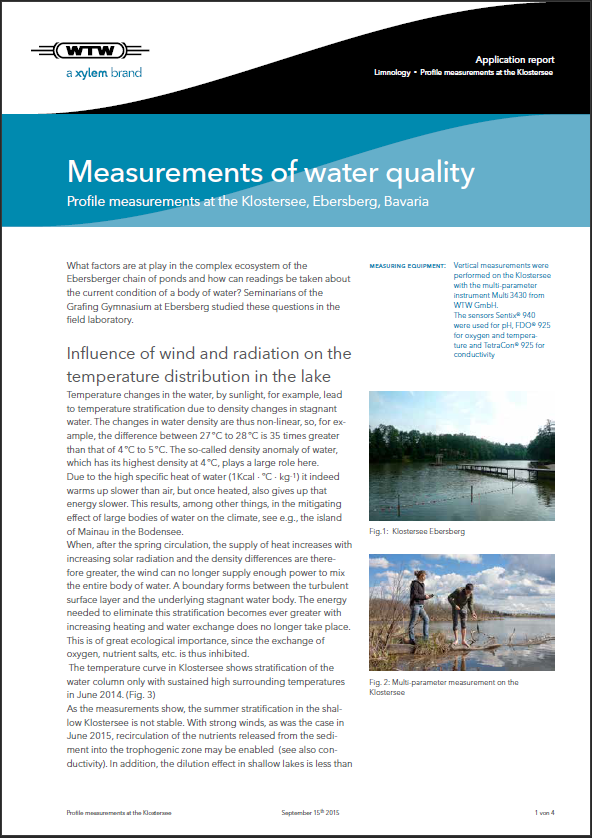Application report
Measurements of water quality
Profile measurements at the Klostersee, Ebersberg, Bavaria
What factors are at play in the complex ecosystem of the Ebersberger chain of ponds and how can readings be taken about the current condition of a body of water? Seminarians of the Grafing Gymnasium at Ebersberg studied these questions in the field laboratory.
Influence of wind and radiation on the temperature distribution in the lake
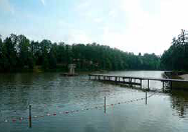
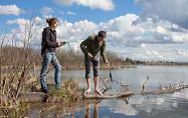
Fig.1: Klostersee Ebersberg
Fig. 2: Multi-parameter measurement on the Klostersee
Temperature changes in the water, by sunlight, for example, lead to temperature stratification due to density changes in stagnant water. The changes in water density are thus non-linear, so, for ex-ample, the difference between 27 °C to 28 °C is 35 times greater than that of 4 °C to 5 °C. The so-called density anomaly of water, which has its highest density at 4 °C, plays a large role here.
Due to the high specific heat of water (1Kcal · ºC · kg-1) it indeed warms up slower than air, but once heated, also gives up that energy slower. This results, among other things, in the mitigating effect of large bodies of water on the climate, see e.g., the island of Mainau in the Bodensee.
When, after the spring circulation, the supply of heat increases with increasing solar radiation and the density differences are there-fore greater, the wind can no longer supply enough power to mix the entire body of water. A boundary forms between the turbulent surface layer and the underlying stagnant water body. The energy needed to eliminate this stratification becomes ever greater with increasing heating and water exchange does no longer take place. This is of great ecological importance, since the exchange of oxygen, nutrient salts, etc. is thus inhibited.
The temperature curve in Klostersee shows stratification of the water column only with sustained high surrounding temperatures in June 2014. (Fig. 3)
As the measurements show, the summer stratification in the shal-low Klostersee is not stable. With strong winds, as was the case in June 2015, recirculation of the nutrients released from the sedi-ment into the trophogenic zone may be enabled (see also con-ductivity). In addition, the dilution effect in shallow lakes is less than that in deep lakes. As a consequence, this shallow lake responds very quickly with strong algal growth to nutrient import from the previous chain of ponds.
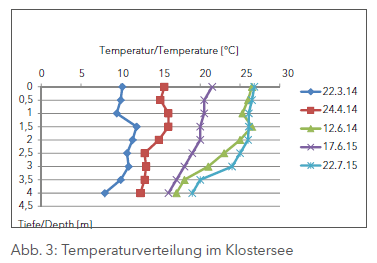
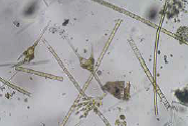
Fig. 3: Temperature distribution in the Klostersee
Fig. 4: Phytoplankton of the Klostersee for the spring bloom
What does the oxygen curve say about the lake?
The oxygen content of the water is of fundamental importance for all organisms in the lake that depend on respiration. The input of oxygen into the Klostersee mainly depends on the photosynthesis of algae and the solubility equilibrium (SE) of atmospheric oxygen in the water. This SE essentially depends on the air pressure and temperature. The higher the air pressure and the lower the water temperature, the more oxygen dissolves in the water.
The measurement on 03/22/2014 occurred during the spring bloom of diatoms and golden algae, Fig. 4, and is reflected in
the high saturation values over almost the entire water column. The typical clinograde distribution of a eutrophic lake is found on 06/12/14: The epilimnion is supersaturated with oxygen, while O2 depletion prevails in the hypolimnion, which can lead to anaerobic conditions in the depths. (Fig. 5
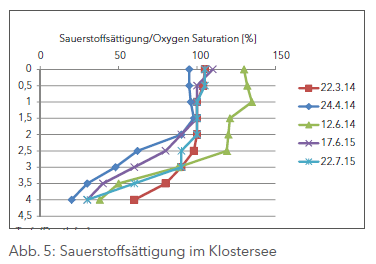
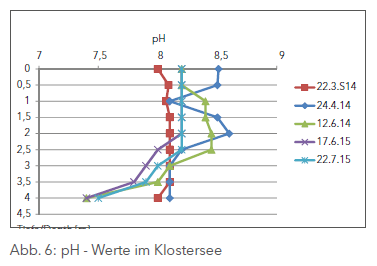
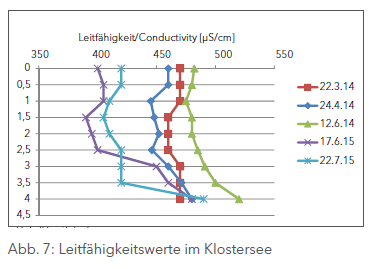
What does the pH value have to do with photosynthesis?
The pH of a body of water is greatly affected by the concentration of carbon dioxide (CO2/carbonic acid equilibrium). CO2 consump-tion by the photosynthesis of algae shifts the pH value into the alkaline range, CO2 production from degradation processes shifts into the acidic range. In eutrophic lakes, the CO2 content decreas-es in the epilimnion through photosynthesis. The CO2 concentra-tion in the deep layer greatly increases through the respiration of bacteria. The pH values of the measurements show corresponding-ly complementary behavior. This can be observed especially well in the Klostersee on 06/12/2014. (Fig. 6)
Conductivity as a measure of nutrient salts in the lake
Conductivity represents a sum parameter for the ion content in the water. This is a quick quick way to determine trends in the dis-tribution of ions in Klostersee, especially using field measure-ments from students. If there is sufficient light and higher tem-peratures, dissolved ions (nitrate/phosphate) are consumed by aquatic plants and algae in upper layers of water. When the algae die off, their dead biomass sinks to the bottom where it is remin-eralized, thus resulting in increased conductivity values above the lake floor. In shallow lakes like the Klostersee, the distinctively low summer stratification and alleviated wind mixing allows the remix-ing of these remineralized ions into the productive zone of the lake, where they lead to lake-internal fertilisation and new growth of algae.
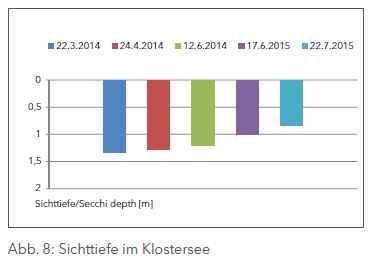
Water transparency (Secchi depth) as an indicator of algae content in the lake
The growth of algae correlates with the so-called Secchi depth, a measure for the water transparency of a lake. The higher the algae biomass, the lower the Secchi depth (Fig. 8). Secchi depths with values of about one meter indicate high nutrient load in the Klostersee.
Conclusion:
On-site measurements with portable meters, with their easy opera-tion and the possibility of immediate use in the field, enable young researchers to be able to quickly understand relationships be-tween metrics, learned theory and cause-effect chains in the lake ecosystem. The findings obtained contribute to being better able to evaluate and reflect on behavioral patterns and their impact on the immediate environment.
Dr. Roswitha Holzmann, limnology and species protection assessments (roswitha.holzmann@ebe-online.de)
Here you can download the whole article as a PDF:
